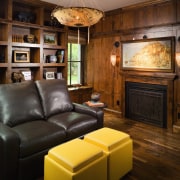Three pavilions
Classical with modern interpretations, this low and horizontal lakeside home makes a subtle, tactful debut into a traditional neighbourhood
The benefits of modern living arrangements with open-plan spaces are fairly well documented. Creating living areas designed around the activities that occur within them has long been considered a method of providing not just physical, but also psychological freedom.
The development of this holistic approach to design is usually attributed to Frank Lloyd Wright and other architects influenced by the renowned Louis Sullivan. Low-pitched roofs, overhanging eaves, single levels with strong horizontal lines and central chimneys are just some characteristics of this style. Many of these traits, or variations of them, can be seen in this lakeside home designed by Timothy Alt, of Altus Architecture.
Located in a region famed for its lakes, this residence is surrounded by homes that reflect typical early 20th-century architecture. Alt's clients had owned the house next door for 12 years, as well as the land upon which this new home was built. But, starting from scratch, they wanted to take a fresh design approach, he says.
"The neighbourhood features houses with stone and timber frames typical of that turn-of-the-century construction plenty of Tudor, but nothing too progressive," says Alt.
"However, my clients are anything but stuffy. They wanted a house with a resort feel that would optimise lakeside leisure activities a home for all seasons, which would be easy to entertain in, yet wouldn't seem out of place in the neighbourhood."
Built on an empty site around mature trees, the house looks as if it may have existed for 50 years. Wooden pergolas, which fit with the natural setting, allow the house to sit quietly in the landscape.
"As well as providing shelter from the high, hot summer sun, the pergolas create an outdoor room that blurs the lines between inside and out. They provide a classical quality that adds layers of interest, depth and shadow," says the architect.
On the entrance side, pergolas frame small windows, creating privacy and extending a sense of mystery to arriving guests. In contrast, the lakeside living areas feature floor-to-ceiling windows that open up towards the water.
Three interconnected pavilions housing the master suite, living, dining and kitchen areas, and guest accommodation offer a modern style of living. The simple floor plan is accentuated by bold detailing, including heavy ceiling beams and rich wooden trim, which ties the house to nature.
The central living and dining area is an open, flexible space that can be easily reconfigured for entertaining. Adjacent to this area is an L-shaped kitchen, which opens out towards the sunroom, as well as a more concealed service kitchen. At each end of the house is an accommodation wing.
On the left of the main entrance is the library a classic timber-lined room with built-in cabinetry and an old-world feel. This in turn leads through to the master suite, with French doors that open towards the lake. The opposite end of the house is a two-bedroom guest wing.
To ensure an appropriate blend of site and surroundings, and to cater for the wide temperature swings between summer and winter, the architect carefully selected building materials.
"We sourced materials that would have been used 100 years ago. The stone walls are New York bluestone that has an antiquated quality; the copper shingles add authenticity and ensure the roof will last a lifetime; and the cedar pergolas are also designed for permanence. Rather than being trendy, we wanted materials that would offer quality over an extended period," says Alt.
Credit list
Interior design consultant
Cladding
Paints and varnishes
Stone walls
Blinds
Story by: Mike Barrett
Home kitchen bathroom commercial design
Personality plus
Diving into nature
Classic looks, contemporary efficiency
















